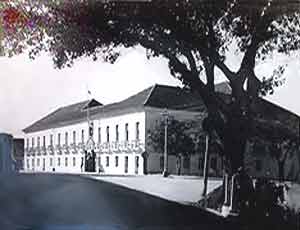 The beginning of the nineteenth century witnessed the end of Maratha power. During 1818 and by the end of the third Anglo-Maratha war half of India was reduced to British pensioners. During this time British held a supreme position and gradually engulfed most of the country. On the other hand the Portuguese territories gradually slipped from their hands.
The beginning of the nineteenth century witnessed the end of Maratha power. During 1818 and by the end of the third Anglo-Maratha war half of India was reduced to British pensioners. During this time British held a supreme position and gradually engulfed most of the country. On the other hand the Portuguese territories gradually slipped from their hands.
Buildings in Goa in Nineteenth Century
During this time the capital was shifted from Goa to Panaji, and the nineteenth century saw the formation of a new capital. In 1695 they had shifted to a palace in Panelim in the suburb of Goa. However by the end of 1759 they decided to shift to the Old Palace of the Adil Shah at Panjim. Earlier new Viceroys landed here to spend the nights before their official entry into Goa. The palace was magnificent and huge enough but it had been large altered on a number of occasions especially during 1887 and later in 1900. Inspite of these alterations it remained the residence of the Viceroy or Governor General until 1918 after which they had shifted to the Cabo Raj Nivas Palace that was earlier the convent of the Franciscans.
At the beginning of the nineteenth century Panjim consisted of the palace which towered over everything else, a few government buildings, and about 200 houses. In 1819 the High Court and the Accounts Office were both relocated to Panjim. In 1821 the first Goan institution to appear was the Gazeta de Goa, the first periodical in the Portuguese State of India.
Dom Manuel de Portugal e Castro acted as the Viceroy from 1827 to 1835. He was considered as the `Founder of the New City.` He had been credited with erecting many buildings and forming spacious roads. He also made a esplanade along Mandovi which was earlier a series of sand dunes, built five primary schools and even established the Public Library. The Customs House was also built during this time and Dom Manuel shifted the Mint to Panjim from Panelim, as well as built many military constructions to secure the city.
 Slowly Panjim became the capital city and more and more buildings were erected to beautify it. One of the oldest buildings in Panjim is the Church of Our Lady of the Immaculate Conception. The first Senate in Asia was founded by Albuquerque in 1511 and occupied the Senate House in Old Goa in between the Cathedral and the Palace of the Inquisition. In 1835 it was moved to Panjim and eventually was moved into its own building in 1869. In the twentieth century it was demolished completely. The High Court building built in 1878 is still in use and is presently the Court of the Judicial Commissioner.
Slowly Panjim became the capital city and more and more buildings were erected to beautify it. One of the oldest buildings in Panjim is the Church of Our Lady of the Immaculate Conception. The first Senate in Asia was founded by Albuquerque in 1511 and occupied the Senate House in Old Goa in between the Cathedral and the Palace of the Inquisition. In 1835 it was moved to Panjim and eventually was moved into its own building in 1869. In the twentieth century it was demolished completely. The High Court building built in 1878 is still in use and is presently the Court of the Judicial Commissioner.
Another important church of Panjim built in 1888 is the Chapel of St Sebastian. The church is noteworthy for its crucifix which was originally used in the palace of the Inquisition in Old Goa. This crucifix was later transferred to the chapel of the Adil Shah Palace in Panjim. From that time the palace was no longer used as the residence of Governor General and was moved to its present site.
Revolts in Goa in Nineteenth Century
The city grew along with its political consciousness and then moved away from Portugal to either find a republic or act as an integral part of the nationalist movement in India. The process slowly gained momentum. Later when the war between the two brothers ended in 1834 a constitutional charter was enforced under the child Queen Maria II and as part of the subsequent reforms, the governorship of Goa was entrusted to a local man, Bernardo Peres da Silva who was sent out to institute a program of radical change.
Such a program could only have been enforced by a senior Portuguese official hence soon a military revolt took place and Dom Manuel de Portugal e Castro who was still in Goa was proclaimed Governor. Although he sent Bernardo Peres da Silva to Mumbai he was not able to prevent a series of revolutionary moves. This resulted in the so-called `massacre of Gaspar Dias`, when the fort of Gaspar Dias was attacked by mutinous troops on 4 May, 1835 and the first regiment and the forts were completely destroyed.
The government of Goa continued to reflect the oppositions in Portugal, but the governorship of the Condede Torres Novas from 1855 to 1864 saw many improvements but the movement which was started by the republican-minded clergy in 1787, continued to grow despite suppression of various kinds.
Apart from these there were certain local Indian problems, one of which was the emergence of the Ranes who had been forced to south in the late eighteenth century. The Ranes were originally a Rajput tribe who had spent many years battling with the Portuguese. In 1895 the Portuguese launched an expeditionary force against the revolts.
Infante Don Afonso, Duke of Oporto and brother of King Carlos, accompanied the expedition and acted as Viceroy for a few months in 1896. The expedition was attacking the Ranes in the northern part of the state for which he used the Souza Gonyalves house in Guirim near Mapusa as his headquarters, an incident still recalled in Guirim. Despite a certain degree of liberalization during the nineteenth century there were still a number of major inconsistencies continued and caused unnecessary offence and suffering.






